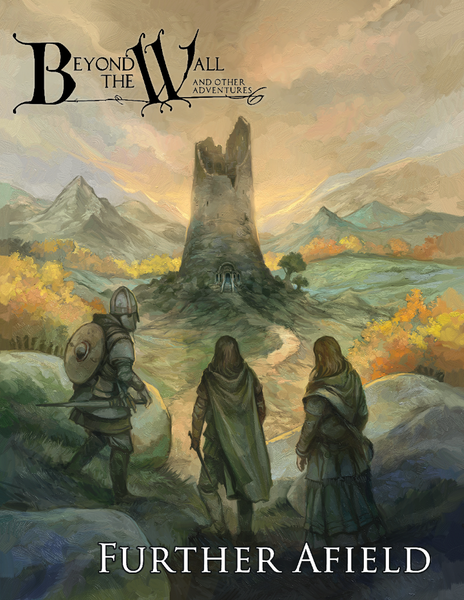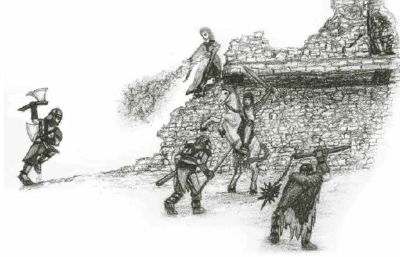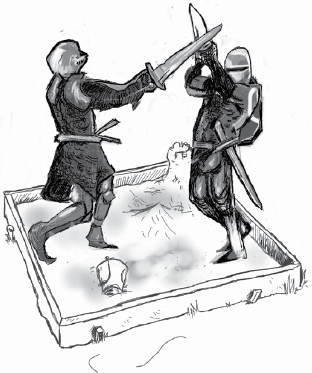Beyond the Wall: Further Afield by GimpInBlack
Shared Sandbox
Original SA postIt's been a long stretch of depressing games about the misery and fundamental corruption of the human condition. It's enough to make anybody depressed. Let's see if we can't lighten the mood with some good old-fashioned kids on adventures. That's right, at long (
long
) last, it's time to start in on:

Further Afield
is the first (and so far only) for-pay supplement for
Beyond the Wall
. Published earlier this year, it expands
Beyond the Wall's
Scenario-based play into material suitable to a long-term campaign. It covers world-building, expanded rules for character progression, travel, and exploration, and adds a new system in the form of
Threat Packs
. Threat Packs are a bit like large-scale Scenario Packs, except that they dictate the course of events over the length of the campaign, rather than setting up a single adventure. If you've played
Apocalypse World
or its descendants, you'll recognize a lot of Fronts' DNA in Threat Packs. This book gives us four: the Blighted Land, the Grey Prince, the Imperial City, and the Vengeful Wyrm. We'll talk about those later, but first let's dive into the Shared Sandbox approach to campaign building.

Holy shit, Saxons!
Shared Sandbox
Further Afield
recognizes three basic structures for building a campaign: there's the traditional campaign where the GM does all the work of world-building and drops the players in. There's the zero-prep option of just running multiple Scenario Packs back-to-back (possibly even returning to the same Pack from time to time, since different rolls on the random tables can produce very different stories). And finally, there's the shared sandbox, where the GM shares world-building authority with the players. As you've no doubt guessed from the title of this section, that's the one
Further Afield
focuses on.
The chief advantage to this approach is, of course, a much higher level of player buy-in. Since the players are coming up with major locations to populate the world themselves, it's safe to assume that they'll be excited to go explore the adventure hooks at those locations. The downside is that you can lose that sense of mystery and discovery, for the very same reason. Fortunately,
Further Afield
has us covered.
To start the shared sandbox process, the GM takes a blank piece of paper (or the campaign worksheet that comes with the book) and places the characters' home village in the center. Then you go around the table and let each player roll 1d8 to determine what kind of location they'll be placing on the map. It might be a Major City (and here we're talking like Rome or medieval Paris), a Source of Power (like a sacred stone or a wizard's tower), or maybe a Monster Lair. At this point you're not mapping things out precisely, so the player should just specify a general direction and an approximate distance from the village (near, moderate, or far; roughly 20-40 miles away, 40-80 miles away, and more than 80 miles, respectively). Exactly how many of these you create depends on how many players you have and how long the campaign is intended to go, but the recommendation is two per player.
So what's involved in creating a major location? The d8 roll gives you a broad archetype, but the player needs to flesh that out a little bit with a description and a hook. Maybe that Monster Lair is the home of a local river goddess and she's been flooding out of season, or maybe that Human Settlement far to the south is the home camp of a raiding tribe who are attacking the outlying farms. Character playbooks and Scenario Packs can provide inspiration here; lots of them have vague mentions of mysterious places that make great fodder for this step. Finally, the player decides whether her character has
seen
this location herself,
heard
about it in rumors from travelers or local gossips, or
learned
about it in old stories or books. This comes into play in the next step.
Once everybody has created their major locations, each player gets an opportunity to add a little embellishment to one of another player's locations, then the GM commences with fuckery. For each location created by a player, the GM rolls a secret Intelligence (for
learned
about locations), Wisdom (for
seen
locations), or Charisma (for
heard
about locations) check for the character. The results of the check indicate how accurate the character's knowledge of the site is, ranging from "hilariously off-base" (the "ghosts" are just old man McGuillicuddy trying to scare people away!) to "not only completely accurate, but here's another hook for you." This is how
Further Afield
deals with keeping that sense of mystery alive in a shared sandbox game, and it's one of my favorite mechanics in the book. You
do
have to be mindful of what, specifically, the player is excited about and not be a dick by rug-pulling that, but it really adds a nice bit of tension when the party starts exploring the map.

Geddit? Geddit?
The rest of sandbox creation is the group kibitzing, tying things together, figuring out what Threat Packs might apply to the setting, what the characters' motivations for adventuring are, and stuff like that. Figuring out where the party wants to go first is also advised, so the GM can prep for the first adventure. If languages are going to be an issue in the campaign, this is also when you start nailing down the languages spoken in the campaign world. Finally, there's this nice little sidebar:
Further Afield posted:
Telling Stories
As an interesting play variant, consider making an actual session of gameplay around the creation of the map and its major locations. Begin the session with the characters in a safe space, like the local inn, and have them tell stories to one another in character while they make the map. This can really drive home to the players just how inaccurate their stories about the major locations might be; it is much easier to remember that Gareth’s tale around the fire about seeing figures in the ruins might be sketchy than it is to remember that John, the player, was not necessarily right when he made up a campaign detail.
The GM can even award experience after such a session, giving 500 xp or so to the players and a bonus of 100 xp to the teller of the most popular story.
I kind of love this as a way of reinforcing the difference between "character knowledge" and "player-authored fact," and would absolutely recommend doing this. Maybe run a Scenario Pack adventure first, just to establish the characters and their world a bit, then do this as the denouement before kicking the campaign into gear.

Next Time: The GM takes the map home and starts fleshing it out, and we add Threat Packs to the campaign world.
Filling the Map
Original SA post Beyond the Wall: Further Afield .Previous Posts
-
Beyond the Wall Part 1: Introduction
-
]Beyond the Wall Part 2: Playbooks and Scenario Packs
-
Beyond the Wall Part 3: Example Characters
-
Beyond the Wall Part 4: Scenario Creation
-
Beyond the Wall Part 5: Magic, Monsters, and Free Supplements
-
Further Afield Part 1: The Shared Sandbox
All caught up? Good. Because we've passed beyond the wall, we've seen the wonders outside the village, and now it's time to go...

Filling the Map
When last we left off, we'd talked about how the group works together to establish major locations they wanted to see appear in the campaign. The next step is for the GM to take all those notes home and turn them into an actual campaign map.
Further Afield recommends doing this on a sheet of 1/4" hex paper, with each hex representing about 10 miles. The assumption is that characters on foot can manage about 20 miles a day, so that will give you a nice, steady average of two hexes per day of travel.
So, the GM takes all the notes about locations from the previous step and, starting from the characters' home village roughly in the center, places the major locations. The goal here is to have several interesting places to visit within a couple of days' travel, and most places they'll want to go being within a week's journey. This might also be a good time to rough in major features like forests, mountains, rivers, and roads.
Minor Locations
Now is the time for the GM to add some surprises to the map. Minor locations are things like small dungeons, monsters' lairs, or helpful hermits out in the woods; places that add color to the campaign world and might eat up a session or so. There's no real limit to how many of these you can make, but generally there's only one per hex at most. If you really dig making locations, you can make up one for every hex on the map, but it's probably more reasonable to make a half-dozen or so at first and add more later. You can even add them to hexes the players have already visited, since unless they made a point of searching every square inch of the hex it's easy to pass a minor location by.
We also get some advice on how to pace out minor locations: in the typical Beyond the Wall game, you'll want roughly an even mix of hostile, friendly, and neutral/could go either way minor locations, and a roughly two to one ratio of mundane places to magical ones. Naturally, these ratios can be skewed based on your group's tastes and/or the map itself: the area around the evil overlord's lair probably has a lot more hostile encounters, and if most of your major locations are mundane you might want to skew more heavily magical in the minor locations as a balance.
We'll get into Further Afield's resources for creating minor locations later, but suffice to say it has some pretty cool tables for quickly generating ideas.
Regions
Regions are a fair bit simpler, and pretty much exactly what you'd expect: forests, hills, river valleys, etc. They're not locations, but areas of the map that contain locations. Every region has a table of encounters, which can include meeting people and monsters, but it can also include environmental hazards, travel difficulties, and the like. The GM can design these herself, but again, there's a nice appendix full of common region types to help out. Encounters can generally be dealt with or avoided with a successful ability check, but some might be played out as a full scene, especially if the initial check fails.
Beyond the Wall: Further Afield posted:
Example Region: Golden Oak Wood
A bright and leafy forest with only light undergrowth and several small streams throughout, the Golden Oak Wood is rumored to be an ancient home of the fae and travelers often find themselves lost under its eaves. Lord Ashspear’s keep once stood on the outskirts of this forest, and history records the forest as the site of an ancient temple to the Horned God. Both could be locations within the region.
We have made this region by adding two additional encounters to the generic woodlands region found on p.73.
There are numerous paths through the woodlands. However, if characters leave the path and go into uncharted territory, this region counts as difficult terrain. Game is plentiful here, giving a +2 bonus to hunting and foraging checks.
Encounter Chance: 1 in 6
1d8 Golden Oak Wood Encounters
- 1 Lost! Make a Wisdom check to find the way or lose a day wandering aimlessly.
- 2 Turned around. Make a Wisdom check or exit from a random hex edge instead of where you thought you were going.
- 3 Deep ravine. Make a Dexterity check to get across or everyone takes 1d4 damage. If you have beasts of burden, also make a Wisdom roll to get them across or lose a whole day.
- 4 Deceptively deep water. Make a Strength check or the guide takes 1d6 damage and loses an item to the current. If you have beasts of burden, also make a Wisdom roll to get them across or lose a whole day’s travel trying to find another way.
- 5 Cursed campsite. Make an Intelligence check or face a minor spirit of anger at night.
- 6 Bear attack. Make a Wisdom check or be surprised by an angry bear.
- 7 Goblin hunting party. Make a Wisdom check or be surprised by 1d6 goblins with an orc leader.
- 8 Faerie. Make a Charisma check or anger a local faerie. Use the stats for the sprite on p.95 of Beyond the Wall and Other Adventures.
Major Locations Again
Finally, it's time to revisit the major locations and flesh out whatever you expect you'll need within the first couple of sessions: dungeon maps, monster stats, NPCs, etc. If any of the PCs ended up with wrong information about a major location, now's the time to figure out what's really going on. There's not a whole lot of specific or unique advice here, but I am going to quote the last paragraph for posterity:
Beyond the Wall: Further Afield posted:
If the players do lead the GM totally off track and decide to head off in the other direction and explore a major location that has not yet been developed, the gamemaster can be upfront with them. There is nothing wrong with saying, “Folks, I know this is supposed to be a sandbox and you should be able to go wherever you want, but I just don’t have that location ready. I really do have some good ideas for it though, and I want to do them justice. Could we agree to adventure somewhere else tonight and then head toward that other location next week?”
Wow, Bill Webb and John Wick would be furious with this game.

Next Time: Threat Packs! Big Bads in Boxes.